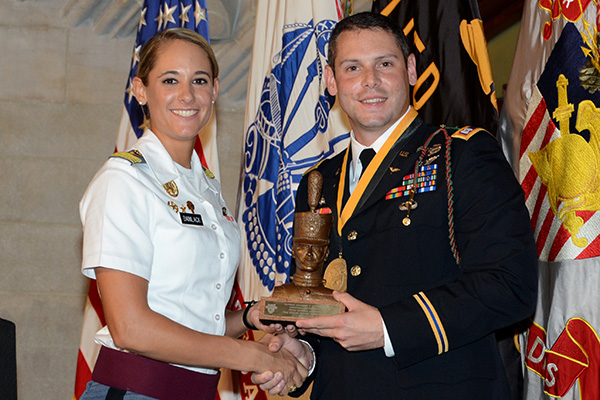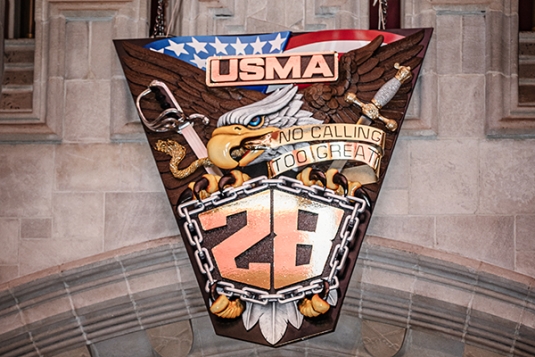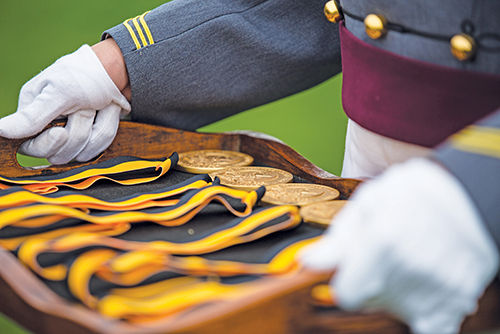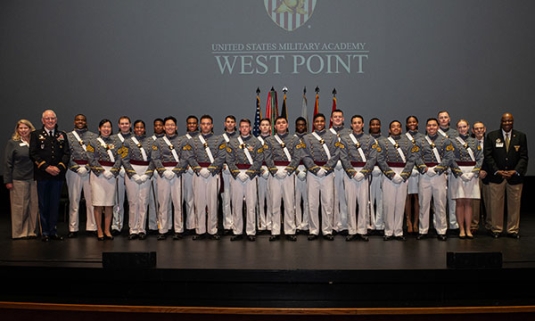On the morning of September 11, 2001, Anthony Fuscellaro ’05 was a plebe who had just completed Beast Barracks and was now overwhelmed by the rigors of West Point academics. Then planes slammed into the Twin Towers and the Pentagon and the United States was at war. “September 11 changed the cadet mindset overnight,” Fuscellaro said. “You enter West Point thinking you are going to do something great, but not knowing what your test or challenge will be.” On the evening of September 11, 2013, after meeting two crucial challenges while serving as a Pilot-in-Command of an OH-58D Kiowa Warrior in support of combat operations in Kandahar Province, Afghanistan, during Operation Enduring Freedom, Captain Fuscellaro returned to West Point to be honored as the eighth recipient of the Alexander R. Nininger Award for Valor at Arms.
The 12th Anniversary of 9/11 also figured prominently in Superintendent LTG Robert Caslen’s ’75 opening remarks to the Corps of Cadets at the Nininger Award Dinner in the Mess Hall. “9/11 birthed a new generation of Americans who saw their country attacked and decided to do something about it,” Caslen said. “Captain Fuscellaro and his peers answered the call of duty to stand in the path between the evil that’s out there and the values of our Nation and our way of life.”
While the SUPT might have been speaking figuratively, Fuscellaro literally flew in evil’s path on two occasions, earning a Distinguished Flying Cross for each run. On August 24, 2009, his quick thinking and actions in combat, which included hanging out the left side of his aircraft to fire M4 rounds at numerous enemy insurgents after exhausting his Kiowa’s supply of rockets and .50 caliber ammunition, created a diversion and allowed an Engineering team on the ground to escape an attack. And on December 24, 2009, Fuscellaro again exposed himself to heavy enemy fire while using all available weapons, including his M4, to take out targets firing at his Kiowa in a triangular ambush.
During his acceptance speech, Fuscellaro shared his thoughts on the role of decision making and training, using his experiences in Afghanistan as illustration. After relating the extreme situations he negotiated, which demonstrated the reality of the fog and friction of war read about at West Point, he told the cadets, “You too will face difficult, spontaneous decision making; when you do, trust your judgment, your critical thinking abilities, and rely on your training.” In an interview before the ceremony, Fuscellaro stated, “Training and leadership lessons at West Point are, in the vast majority of cases, very subtle, but ultimately West Point teaches cadets to perform under stress from Day 1.” He added to this in the conclusion of his speech saying, “Combine demanding training with your West Point leadership education, and you will successfully lead our Nation’s sons and daughters.”
For his success, Fuscellaro earned the Nininger Award, which is named for Second Lieutenant Alexander R. Nininger ’41, who posthumously received the first Medal of Honor in WWII, and is endowed by E. Douglas Kenna ’45 and Jean Kenna. However, he does not necessarily see his acts as special in any way. Addressing the valor aspect which earned him the award, Fuscellaro said, “It wasn’t a choice to be valorous or heroic; it was simply a choice between two options—both bad—and West Pointers are taught to choose the one that put others ahead of ourselves.” He was also humble when explaining the success of the Class of 2005, which has been awarded four of the eight Nininger Awards presented. “My class has known nothing but war over the last 12 years, so the opportunity has been there for us to succeed,” he said. “Fortunately, many from ’05 have done so… far more than have been recognized by a Nininger Award.” As the 2013 recipient, Fuscellaro will represent all West Point commissioned officers who have served in combat. He is off to a great start.
Speech
LTG and Mrs. Caslen, Mrs. Kenna, Mr. Glore, distinguished guests, and the great Corps of Cadets, thank you for this honor. I am humbled to receive the 2013 Nininger Award, especially on an evening so sacred to our country.
My classmates and I were plebes on September 11th 2001 and I still have chilling memories of the taps vigil the Corps conducted that night. Since then—for twelve years now—our nation has been at war, and the Long Gray Line, as well as our families, have borne some of the heavy burden of the war on terrorism.
My class, 2005, and many others, know first-hand the exhilaration and, at times, the near despair, of “Keeping Freedom Alive.” Ten of my classmates made the ultimate sacrifice. Most recently, CPT Scotty Pace, a fellow Kiowa Warrior pilot, died in a crash following a firefight in Afghanistan last year.
Three classmates have preceded me on this stage, receiving the Nininger Award, and countless others have quietly distinguished themselves in combat. I accept this award on behalf of them all with special thoughts for our two most recent combat losses—MAJ Jaime Leonard ’97, and CPT Sara Knutson ’07. Both were killed in action this spring while I was in Afghanistan. While the Long Gray Line keeps us strong, we are all diminished when Taps is played for our fallen comrades.
Carl von Clausewitz wrote extensively on the fog of war, and even Sun Tzu recognized the need for spontaneous decision-making in combat. I am no expert, but for the next few minutes, I would like to share some thoughts on decision-making and training in combat, using my experience in Afghanistan as an illustration.
In August of 2009, I was a new Kiowa Warrior Pilot-in-Command. I had been in Afghanistan for about four months. On the hot and hazy morning of August the 24th, a recently arrived Engineer platoon was patrolling Highway One near Kandahar City.
The twenty-man platoon was operating about 8 miles from Kandahar, and my scout weapons team knew the engineers were approaching a bad area. In fact, they had already taken harassing small arms fire, but the source could not be precisely identified among the numerous one and two-story mud structures.
My team quickly refueled, but when we returned to the platoon’s location, their situation had drastically changed. The engineers had found a roadside bomb, and decided to dismount and exploit it. They followed the command wire, which is just a thin lamp cord the insurgents use to detonate explosive devices. The engineers slowly traced the cord one hundred and fifty meters south, but they didn’t know they were now in the most dangerous town in Kandahar province.
The engineers’ initiative combined with their lack of intel on the area had led them deep into a complex ambush. Now, they were taking sustained and effective heavy machine gun fire from multiple angles. Our scout team comprised of two Kiowa Warrior helicopters immediately started firing in the platoon’s defense. We identified dozens of heavy weapon positions. When we engaged them, the insurgents fired RPGs and anti-aircraft guns at our aircraft.
The twenty Army engineers were now dismounted from their armored vehicles and in grave danger. We radioed the engineers that we had identified about 100 heavily armed insurgents surrounding their platoon’s position.
After a long 25 minutes of fighting, the engineers had become divided, half on a rooftop, and half pinned down inside their two vehicles well within the enemy kill zone.
When we had expended all of our ordnance, our team had to refuel and rearm. Fifteen minutes later, flying as fast as possible, we returned to the massive firefight. Radio transmissions were filled with the sound of gunfire. Every pass we made was met with unforgettable sounds: the snap of small arms, whistle of RPGs, and thuds of anti-aircraft fire. On station for another fifteen minutes, we destroyed dozens of enemy fighting positions only to see others become active.
And the armored vehicles remained in the kill zone. They had taken heavy damage, and were not going to last much longer. The engineers in them couldn’t escape because they had to turn their vehicles around, and deep ditches surrounded the narrow dirt road on either side. They needed someone outside the vehicle guiding the turn, and the intense fire from positions just meters away made their escape impossible. We continued to engage the positions for the next thirty minutes but there were too many insurgents with heavy weapons.
Now — more than an hour and half into intense fighting — we were out of ammunition again. My team analyzed every option, looking for a clear course of action. None was ideal. If we left the scene, the insurgents would overrun the engineers. But if we stayed, all we had left were our personal firearms—M4s—to defend ourselves and suppress the insurgents.
Army field manuals say personal firearms should be used as a last resort—for defense on the ground. And there are procedures to fire the M4s from aircraft in very low-threat situations—to eliminate one or two insurgents while minimizing collateral damage. But this situation was not suited to M4 fire, because we would have to fly very slow, and very low to effectively engage the insurgents. Doing so would almost guarantee our taking several hits and the likelihood of a downed aircraft.
But in combat you often have to continue without clear solutions. The fog and friction of war that we all read about here is real. So, after a quick discussion with LTC Mike Morgan, Chief Warrant Officers Adam Fletcher and Toby Familo, we decided we could not leave. We would use our aircraft to distract fire from the exhausted ground troops, flying slowly at tree-top level shooting the M4 to draw fire away from the engineers so they could escape the kill zone.
We made two very dangerous passes, and I hung out the left side of our Kiowa. On each pass I fired two magazines of 5.56 rounds. We received heavy fire, but the diversion we presented allowed the engineers to turn and escape.
My point in telling you this story is that there was no clear course of action, and still we were forced to make a decision based on our adapting tactics, assessing the enemy’s tendencies, and, above all, making an imperfect and rapid risk analysis. You will face difficult spontaneous decisions too, in this war or the next. When you do, trust your judgment, your critical thinking abilities, and rely on your training.
I would like to conclude with a word about training. I believe those combat engineers and our scout weapons team survived because of the demanding training we had endured. During that year in combat my key trainer was LTC Morgan, and his approach to aerial marksmanship was exacting and demanding. He expected every round needed to be a direct hit.
For example, if we were shooting at a vehicle, we would call out the tire or window for which we were aiming. If the vehicle was hit, but the aim point was not hit, then your shot was a failure. As we became more skilled, we would toss a colored smoke canister out the door and hit the 6-inch piece of tin before the smoke dissipated. The standard was well above what was required in manuals. In fact, in most cases, the training standard exceeded what was required in actual firefights.
I flew hundreds of missions with LTC Morgan, and his standard was always the same. We would return from flights in which we had killed insurgents only to talk extensively about my missing a shot by a foot or two during test fire prior to the mission. His demands were often frustrating, but that morning in Kandahar our shots were successful because of our standard of perfection. Muscle memory acquired through repetitive and focused drill had taken over.
I encourage each of you to be like Colonel Morgan. Set the bar very high. Your Soldiers will rise to your expectations. Also, you will find that the various challenges here at West Point are building your ability to think and act under stress. Combine demanding training with your West Point leadership education, and you will successfully lead our nation’s sons and daughters.
As the wars of the past twelve years conclude, we can be sure that the global environment will remain dynamic and volatile. However, no matter what the years ahead may bring, the timeless leadership training here provides you a sound guide and foundation.
To the Corps, thank you for your attention this evening. General Caslen, Mr. Glore—and Mrs. Kenna, thank you for your courtesies toward my wife Adrianne and my family present tonight.
I am honored to represent—for this one evening—the great West Point warriors of the past, present, and future.
Go Army, Beat Navy!




